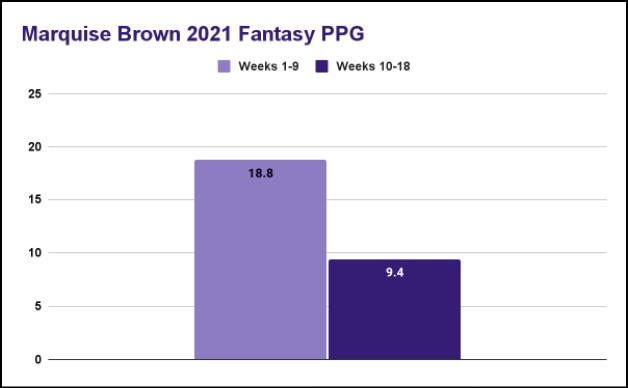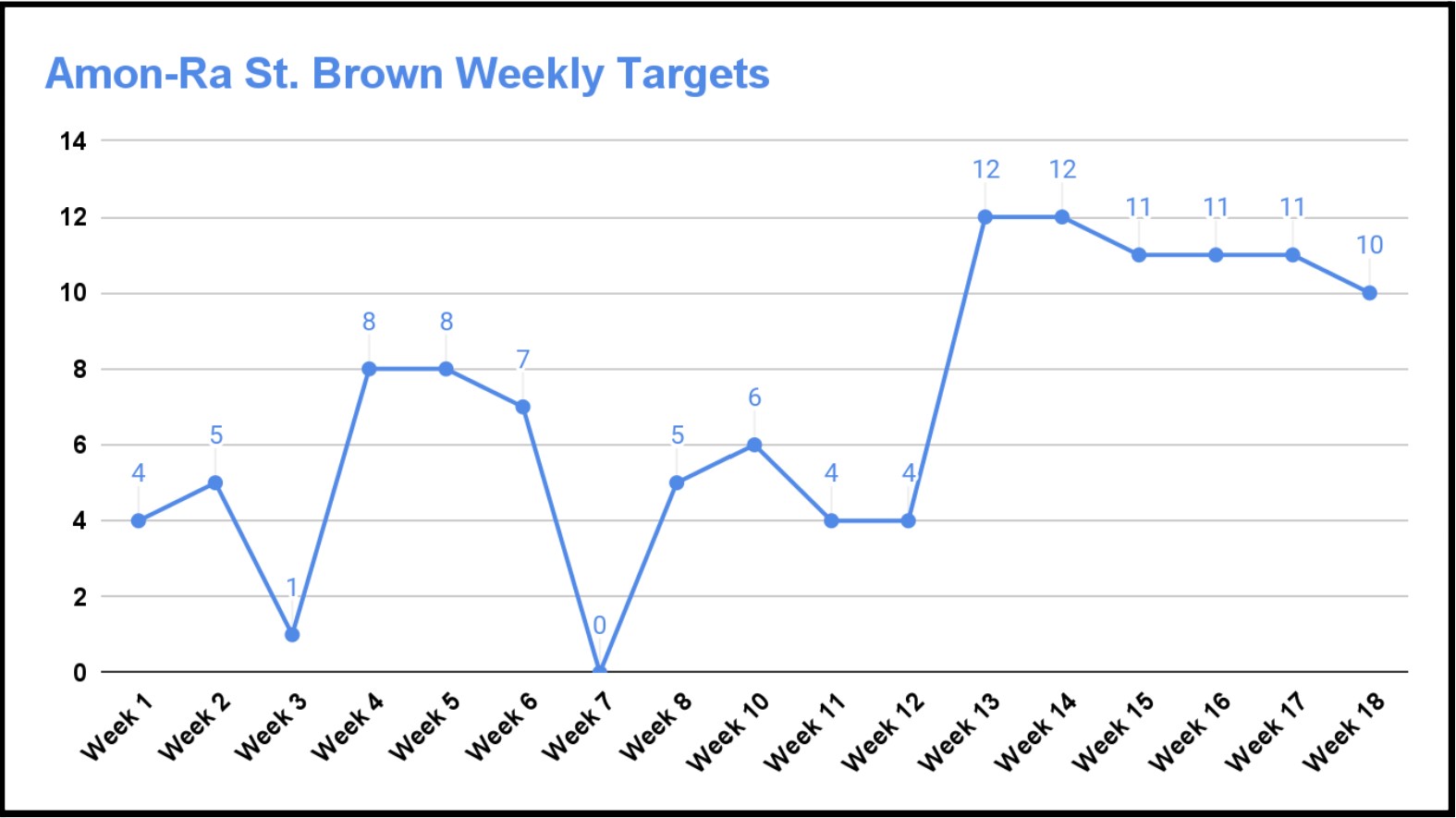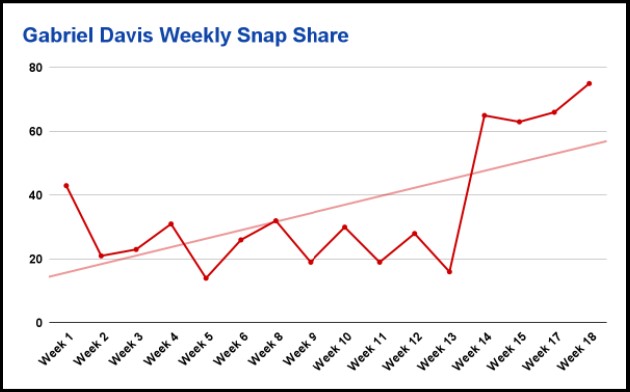5 Wide Receivers That Need to Be Viewed in Greater Context
One of the most important aspects of fantasy football analysis is context. Without context, a player can be very easily swayed to view a player in a certain light based on end-of-season totals. A player’s box score is an important piece of information to become familiar with, but it can create a picture for a player that might not match their production for the next season. Sure a player might’ve had some impressive numbers, but does that really tell the full story?
Here we are going to be looking at five wide receivers that need to be viewed with more context than they have been to this point in the offseason.
Marquise Brown (BAL)
Marquise “Hollywood” Brown had an interesting 2021 season. In one half of the year, he was a pleasant surprise for managers that rostered him as he was the WR6 from Weeks 1-9. For the second half, he fell off pretty hard and closed out the season as the WR22. The second half fall-off has Brown labeled as somewhat of a puzzling case and his value seems to be in purgatory. But when looking at the role that Brown has acquired in this offense and what the Ravens were dealing with in 2021, he should be valued higher than where he is right now.
In 2021, Hollywood Brown was used heavily as a weapon in the Ravens offense. He finished the year with 145 targets (10th most in the NFL) along with 1,518 air yards (11th most in the NFL). In this Baltimore offense, Brown clearly benefits as one of their main weapons.
Now Brown’s drop-off does provide some cause for concern. But there are multiple factors that were at play for the Ravens in Weeks 10-18. Prior to the season, the Ravens lost all hope for their run game with injuries to J.K. Dobbins and Gus Edwards. This made the offense fairly predictable as defenses started to catch onto the fact that a combination of 2016’s best running backs wasn’t working out.
This was exposed during the Ravens’ Week 10 Thursday Night loss to the Dolphins. Miami knew the Ravens had no run game and a predictable scheme as a result, so they stayed in pretty much the same formation for the entire duration and shut down Baltimore’s offense.
After that loss, you need to look at the health of Lamar Jackson. Jackson missed Week 11 with an apparent illness and when he returned in Week 12, he just wasn’t the same quarterback. In a two-week span, he threw two touchdowns and five interceptions. Jackson then injured his ankle in Week 14 against Cleveland and was out for the remainder of the season. While Tyler Huntley was respectable in Jackson’s absence, the offense just wasn’t the same and Marquise Brown was not benefitting from the change.
When looking at the circumstances surrounding Brown’s second-half collapse, you really can’t blame him for not keeping up the same production he showed in the first eight games. The offense was in flux and the potential for success fell as a result.
Brown should be viewed higher than where he is right now. He’s a much better receiver than what those final eight games show and he has higher level usage. Hollywood being valued behind players that aren’t even WR1 in their own offense is ludicrous. Expect him to prove the doubters wrong in 2022 and beyond.
Hunter Renfrow (LV)
Hunter Renfrow flashed onto the fantasy scene in 2021 and surprised everyone with his “Cooper Kupp light” type of performance. He finished as the WR10 with 103 receptions, 1,038 yards, and nine touchdowns. While he was fairly consistent with nine double-digit performances through the first 11 weeks, Renfrow took his game to another level from Weeks 12-14.
During that three-week stretch, he put up three straight 100+ yard performances while commanding a 48.5% target share among Raiders wide receivers. He came back to earth during the final four weeks, but his productive season and new pairing with Josh McDaniels has plenty of people looking at Hunter Renfrow as a breakout candidate for 2022. But before he’s crowned, we need to look back on why Renfrow had his impressive 2021 season.
The main aspects of the Raiders’ season that contributed to Renfrow’s growth were the Henry Ruggs incident and Darren Waller’s injury. Ruggs was removed from the Raiders after Week 7 and Waller was injured during the second quarter of Week 12. The Raiders really had no choice other than throwing to Renfrow for a period of the season, which may have led to his impressive three-week stretch where he was peppered with 33 targets.
We also need to look at his fall back to earth. After Week 14, Hunter Renfrow saw his targets fall as Zay Jones was actually receiving a heavier share throughout that time. From Weeks 15 – 18, Zay Jones held a 44.3% target share among wide receivers while Renfrow’s dropped down to 27.8%. This shows that he might not have the strong opportunity in this Raiders offense that some people think he has. Another receiver could easily steal a larger share in 2022.
While Josh McDaniels does have a history of favoring receivers with Renfrow’s playstyle, the Raiders have recently traded for Davante Adams. As a receiver who is widely recognized as top-3 in the NFL, he will likely take a strong majority of the wide receiver targets in Las Vegas. Also, the return of Darren Waller will surely spread the targets around once again, leaving Renfrow with a further depleted target share.
Hunter Renfrow is certainly a talented and reliable receiver, but the fantasy community needs to take a step back on his offseason hype. For 2022, Renfrow should remain around WR3 range but moving him into the WR2 area seems like a bit of wishful thinking with the obstacles present in Las Vegas.
Win Your Fantasy League!
Become a member at FantasyData and get access to the industry’s best fantasy football subscription available!
Stefon Diggs (BUF)
Coming off of a fantastic 2020 season, Stefon Diggs returned with more of the same in 2021. He finished as the WR7 with 1,200+ yards and 10 touchdowns. Somehow though, managers will continuously say that rostering him was a bit of a disappointment in 2021. The reasoning for that may be that Diggs was lacking those real “boom” performances that people were used to seeing in 2020.
In 2021, Stefon Diggs only managed to break 100 yards twice while putting up over 20 fantasy points five times. When looking at his season that way, it can be easy to understand the disappointment that managers were feeling. His WR3 price tag during draft season definitely didn’t help either. While Diggs’ 2021 may have been slightly underwhelming in comparison to his electric 2020, there is more to his performance than the end-of-season numbers.
Stefon Diggs’ season had the potential to actually be better than his 2020 season based on some of his underlying statistics. Diggs had 1,828 air yards (2nd in NFL) which were actually 100 more than what he had in 2020. His unrealized air yard total was high as well with 923 (2nd in NFL). He also led the entire NFL in end zone targets with 23, eight more than the next closest player. According to these numbers, Diggs had a shot at putting up an incredibly explosive season, one that was much better than his WR7 finish.
For 2022, Diggs could be in line for a major bounce-back year with the usage and opportunity that is presented to him in Buffalo. Now that he is currently falling from his WR3 ranking just a season ago, Stefon Diggs could be a fantastic get for drafters in all formats. In a Bills offense that excels at passing the ball, Diggs has the potential to majorly outperform his 2021 numbers while becoming a massive value for managers despite still being seen as a top-10 wide receiver.
Amon-Ra St. Brown (DET)
Quickly rising as the most polarizing wide receiver in the fantasy space is the sun god, Amon-Ra St. Brown. St. Brown was a talented prospect in the offseason but quickly rose to household recognition with his run of dominance for the final six weeks of the season. He finished the year as the WR21 but for the final six-week stretch, he was the WR2 behind only Cooper Kupp in fantasy ppg.
Amon-Ra was also the recipient of a 47.8% target share from Week 13 and on among Detroit wide receivers. That target share ranked for third-highest in the NFL during his stretch run. For a player that hadn’t seen more than eight targets in a single game, his sudden spike to 11 targets per game can look a little surprising to someone glancing at a week-by-week breakdown of St. Brown’s performances. Why did his opportunity suddenly rise? Well, there’s a pretty simple answer to that based on who the Lions had available to them.
First, the Lions had been without their most involved playmaker in D’Andre Swift due to an injury on Thanksgiving. Swift had been seeing 18.5 total opportunities per game (carries + targets) and his absence forced the Lions to move toward a more pass-heavy approach. Then, in the next week, T.J. Hockenson went down with a hand injury that knocked him out for the remainder of the season. So, in a two-week period, the Lions lost their most dynamic playmaker and the team’s leading receiver. With a receiving core made up of St. Brown, Kalif Raymond, Josh Reynolds, KhaDarel Hodge, and Tom Kennedy, the Lions really had no choice other than throwing to Amon-Ra St. Brown on most offensive possessions.
Amon-Ra St. Brown definitely showed his talent with the targets that were given to him and he should continue to be a strong contributor to a Lions offense that is on the rise. But it can’t be ignored that he was pretty much the only real weapon available to the Lions during the final six weeks of the season. St. Brown earned a decent spot in this offense but Swift should return to his previous role while T.J. Hockenson remains as a strong receiving threat.
Detroit is reported to be welcoming in former Jaguars receiver, D.J. Chark, which will crowd the receiving room a little more. They are also rumored as a potential suitor for an early-round wide receiver in the upcoming draft. Just know that Amon-Ra St. Brown is a very skilled receiver but his 2021 season is looking similar to 2020 Brandon Aiyuk. When he was virtually the only weapon, he was great, but a 10-12 weekly target average isn’t feasible with a healthy and retooled offense.
Gabriel Davis (BUF)
Here we have the second Bills wide receiver on this list in Gabriel Davis. Davis is up there with Amon-Ra St. Brown as the most contentious wide receiver in the 2022 offseason. On one hand, people will be quick to mention his jaw-dropping 201-yards and four touchdowns in the divisional round of the playoffs as a reason for his looming breakout season. While that outing was the stuff of legend, naysayers will point to his minuscule regular-season numbers through his first two years in the NFL. Through constant disagreements about the true value of this enigma of a receiver, it is important to not be swayed to the extreme sides of this argument without any real context.
When you look at Davis’ usage in 2021, it’s hardly impressive as he finished the season with a 14.2% target share among Bills wide receivers. But when you view the season in two different ranges, there was some improvement. In Weeks 1-9, Davis had a measly 7.9% target share among wide receivers. Then, in Weeks 10-18, Davis took over the WR2 role in Buffalo with a 20.1% target share while accumulating 75% of his total yardage. Most of this was due to the personnel available as Emmanuel Sanders was battling a knee injury from Week 14 until the end of the season.
Based on the acquisitions the Bills have and haven’t made so far, it seems like Davis has the trust of the organization. Emmanuel Sanders hasn’t been re-signed and Cole Beasley was recently released. The team also picked up Jamison Crowder but he operates almost exclusively from the slot.
It seems like the Bills have a plan in place to use Jamison Crowder in the Cole Beasley role within this offense while Gabriel Davis takes over the role that Emmanuel Sanders was operating from during the early portion of the 2021 season. In the first six weeks of last season, Sanders was actually a valuable fantasy asset as he ranked in the top-25 wide receivers (WR23). So, a top-25 finish for Davis shouldn’t be out of the question in 2022 if the Bills utilize him in a similar fashion.
Gabriel Davis should be viewed in a middle ground area. Rather than seeing him as high as the second coming of Rice or as low as WR60, view him as a player with potential for a greater role in a very productive passing offense. I can’t get behind putting him above players like Allen Robinson, Chase Claypool, or Brandin Cooks. But just because a player doesn’t have high usage after only two years in the league, it doesn’t mean they can’t emerge into a larger opportunity. Gabriel Davis probably won’t be carrying your team, but he should be able to provide solid production if he’s able to maintain this outside WR2 role he has inherited in Buffalo.



